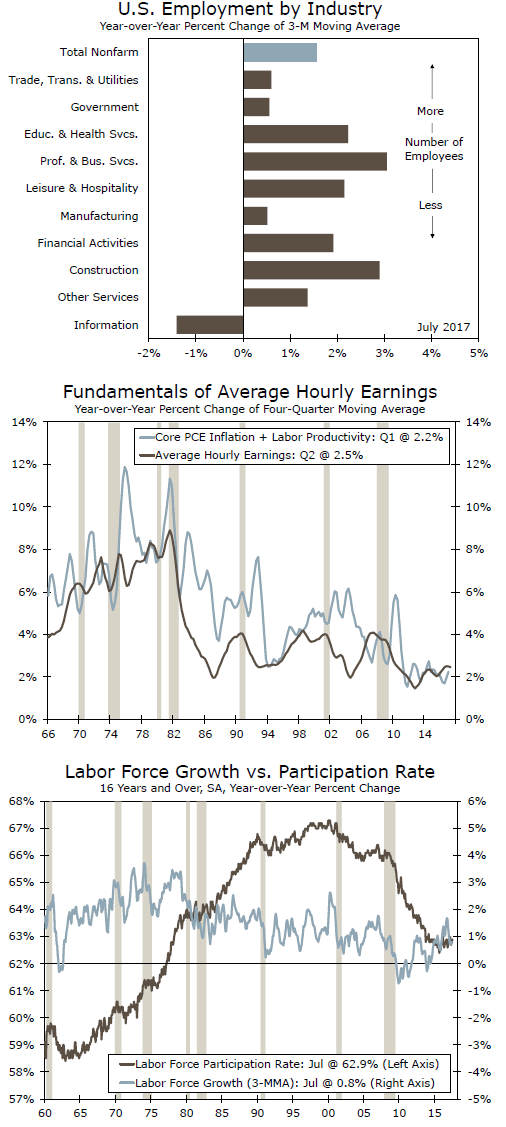Solid July job gains of 209,000 and a steady rise in wages indicate continued economic growth and consumer spending. Beyond the cycle, structural unemployment issues remain.
July Jobs Up 209,000: Consistent with Economic Growth
Nonfarm payrolls rose a solid 209,000 in July, with the three month average at 195,000 jobs. Job gains are consistent with 2 percent plus economic growth, steady consumer spending and Fed policy as currently projected for a December rate hike.
Hiring in the services sector remained solid, with gains in business services, education & health, finance and leisure & hospitality (top graph). Federal government jobs have risen 11,000 on average over the past three months. In the goods sector, manufacturing employment posted a strong gain over the past two months, while hiring in construction was up a modest 9,000 jobs on average over the past three months.
Wage Growth: Where Do We Go from Here?
Persistent gains in jobs continue to outpace the growth in the labor force, thereby putting downward pressure on the unemployment rate and modest upward pressure on wages.
Average hourly earnings rose 0.3 percent in July, an increase from the 0.2 percent pace the previous month. The year-ago pace of wage growth remained at 2.5 percent, the fourth consecutive month at this rate. While job growth remains strong, earnings continue to struggle to break out of this mid-two percent pace. The softer inflation readings and weak productivity numbers have limited the gains in nominal wage growth. On balance, average hourly and weekly earnings continue to improve and, along with more jobs, support the case for household income gains.
Over the longer run, wages reflect the economic fundamentals of the labor market, and those fundamentals include productivity and inflation (middle chart). During the current cycle, low productivity has been a theme that has helped explain lackluster wage growth. Moreover, inflation has been persistently below the FOMC’s target of two percent. With both productivity growth and inflation continuing to prove sluggish, it is not altogether surprising that wage growth has disappointed given the performance of the fundamentals.
Structural Problems Persist: Drag on Growth
Labor force growth has picked up over the last year and is a healthy sign for continued economic growth with limits on the rise in average hourly earnings. Yet, the current pace of labor force growth is not enough, without additional productivity gains, to kick up economic growth into the 3 percent range. Meanwhile, the labor force participation rate has remained fairly stable. In an odd turn of events, labor force participation in July is higher for less-than-high school and high school workers but down for some college and bachelor’s degree workers. Perhaps less-educated workers are being enticed into the labor force while more educated workers are less involved as gains in income and wealth have allowed a change in lifestyle.













